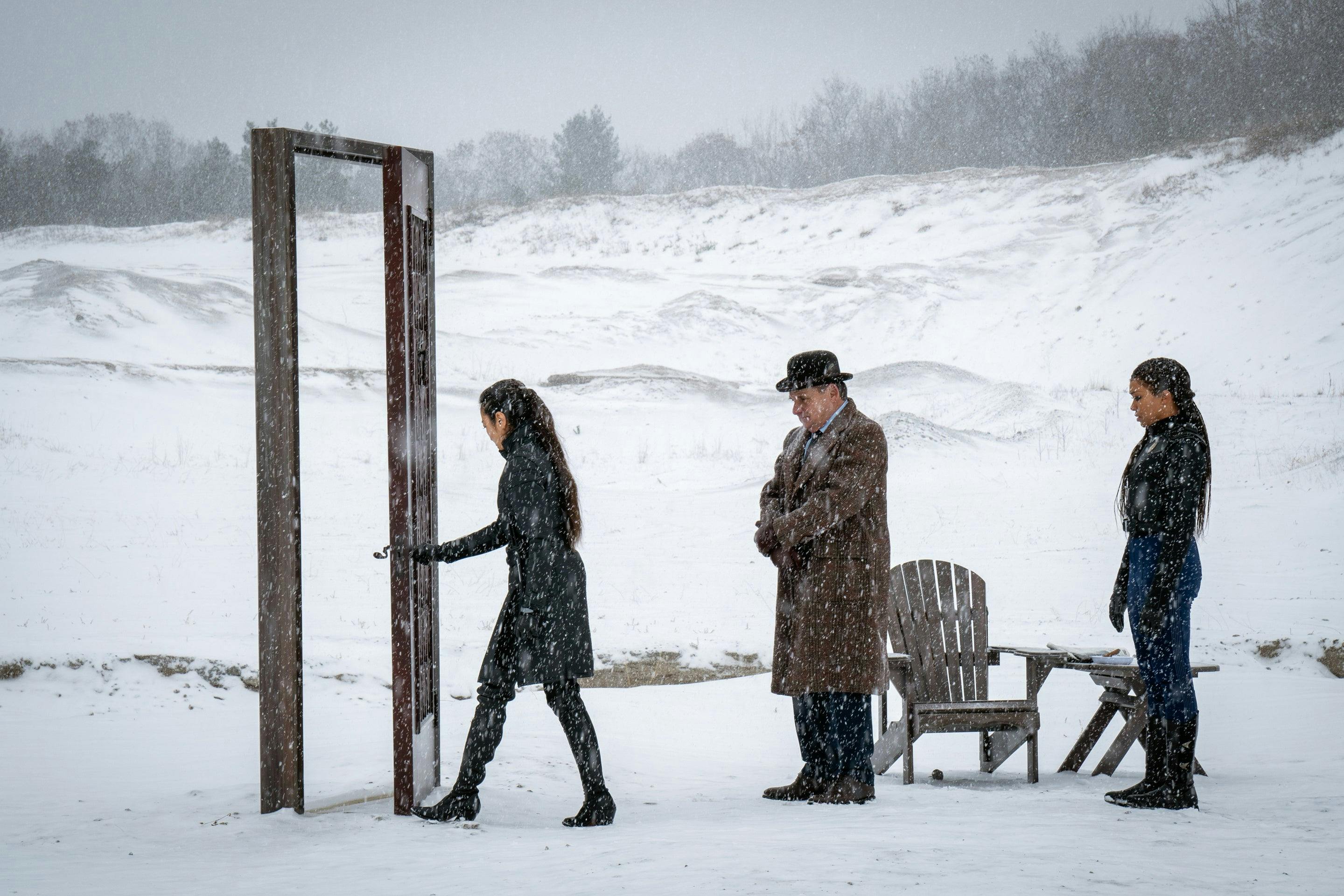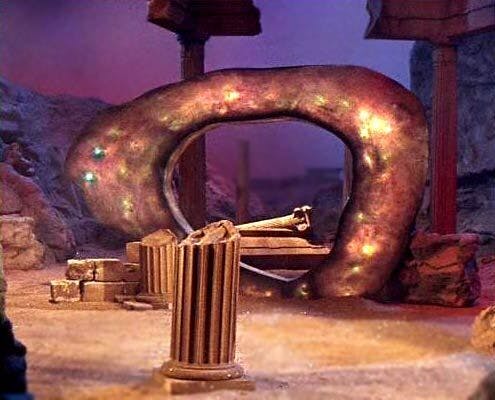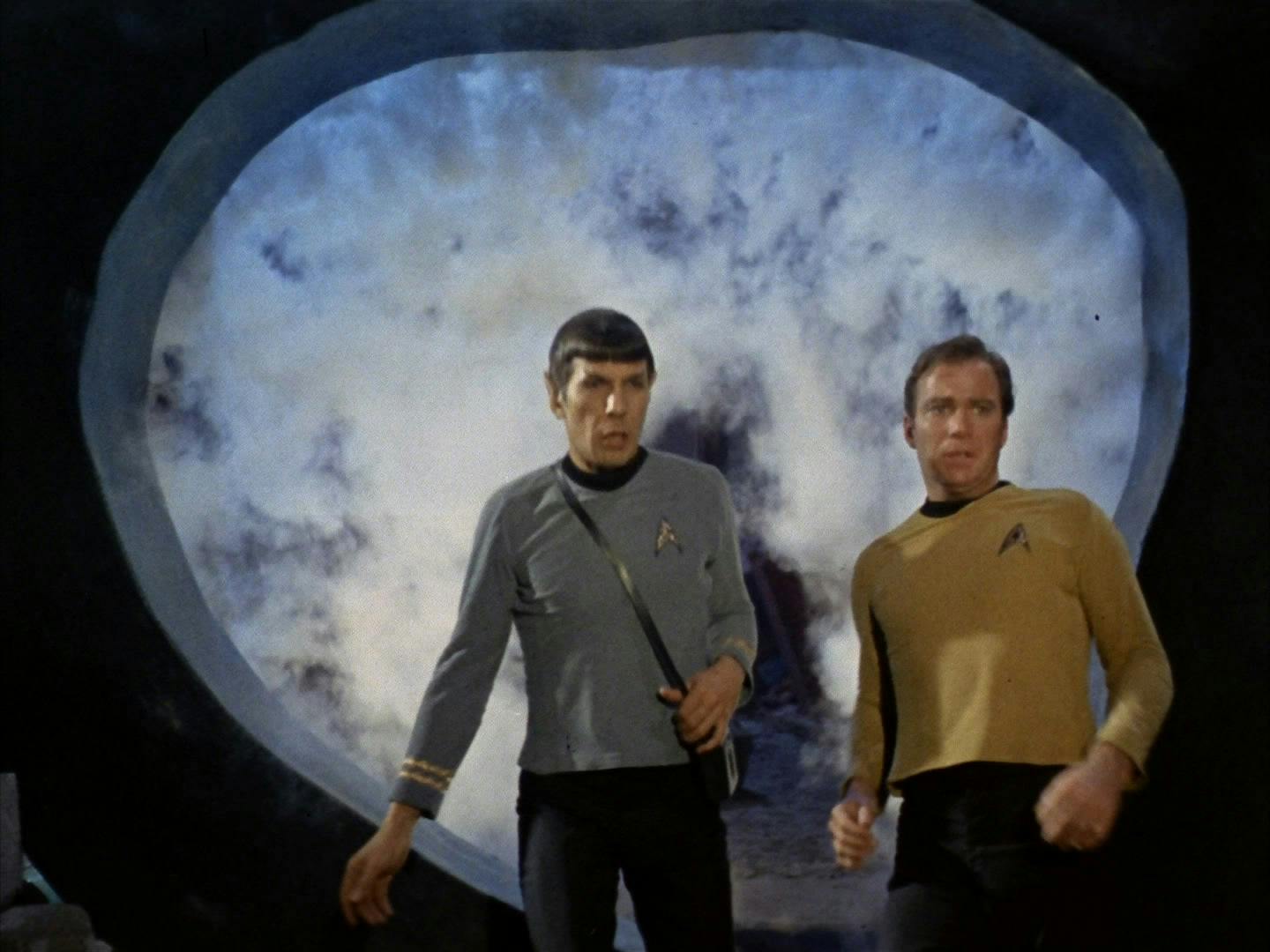Published Dec 18, 2020
7 Things You Didn’t Know About the Guardian of Forever
(...and won't be ready to learn until after this week's episode of Star Trek: Discovery! Spoilers ahead.)

StarTrek.com
In “City on the Edge of Forever,” the Guardian of Forever told Captain Kirk that it “couldn’t change,” but nine centuries later, we return to find that the Guardian of Forever has changed, and now lives in disguise as a kind spacetime entity named “Carl.” In the Star Trek: Discovery Season 3 episode “Terra Firma Part 2,” we learn that the portal Georgiou stepped through in Part 1 was no ordinary door. Yes, it took her to the Mirror Universe, but now, it seems, it will take her to another time — back before the Prime Universes and the Mirror Universes diverged.
Episode Preview: The City on the Edge of Forever
The powers of the Guardian of Forever have returned, for the first time on screen in four decades. First introduced in the famous Original Series episode “City on the Edge of Forever,” the Guardian of Forever has only been glimpsed one other time before this week, in The Animated Series episode “Yesteryear.” Still, despite these scant appearances, the Guardian of Forever remains one of Star Trek’s most enduring images. Now that it has returned, it's time to set through our own time portal and briefly explore the various secret histories of this gateway to the past.
As a result of spacetime anomalies, parallel dimensions, and temporal inclusions, the history of the Guardian might be confusing. To help clear things up, here are seven things you (probably) didn’t know about the Guardian of Forever. Behold!
There were originally a bunch of Guardians
Infamously, writing of “City on the Edge of Forever'' took a long time. The story outline was assigned to Harlan Ellison in March of 1966, but it wasn’t until February of 1967 that the script was finished. There are several reasons why, and those stories literally fill several books. From The Fifty Year Mission by Mark A. Altman and Ed Gross, to Ellison’s own City on the Edge of Forever Book, the various reasons why Ellison’s script was revised several times are as controversial as they are… fascinating. In the book Inside Star Trek: The Real Story, producers Herb Solow and Bob Justiman have an entire chapter dedicated to the episode, titled: “Waiting For Harlan.”
So, what does all of that have to do with the “original” Guardian of Forever? Well, briefly, Ellison’s original script was far more complex and significantly darker than what ended-up on screen. And one aspect of his original teleplay included not one “Guardian” but instead, a race of beings called the “Guardians.” In that teleplay, the Guardians were depicted as huge, towering above Kirk and the crew. You might think it is strange that the Guardian of Forever is now, more or less, a person, but in a sense, Discovery has paid homage Ellison’s original concept by giving the Guardian of Forever a humanoid persona. You can see what these original Guardians looked like in the 2014 IDW comic book series called Star Trek: Harlan Ellison’s The City on the Edge of Forever, the Original Teleplay.
In 2016, Skyboat Media also released an audioplay, partially narrated by LeVar Burton, which adapted the original teleplay.
Harlan Ellison’s admitted his memory about “ruins” was faulty

StarTrek.com
For years after “The City on the Edge of Forever” aired, Harlan Ellison frequently said that he had never intended for the “ruins” of a city to appear on the Guardian planet, but instead, had intended that the portal be adorned with mysterious “runes.” This tale of “ruins” versus “runes” was repeated by Ellison a lot, including a 2007 documentary about his life called Dreams With Sharp Teeth. But in the back pages of the second issue of that 2014 IDW Star Trek comic book, Ellison admitted that some kind of alternate universe situation may have occurred in real life! Basically, he couldn’t find anything in his old teleplays to back-up the idea that he’d originally written “runes” instead of “ruins.” Writing the IDW letter section of issue #2 of that miniseries, Ellison said: “I went back over every snippet of all the script incarnations and, to my surprise, the word ‘runes’ does not appear.”
The explanation? Essentially, Ellison thinks that Matt Jefferies, one of the legendary production designers on The Original Series probably misheard him when he’d said something about “runes” being on the time portal. “I may have garbled it in speaking,” Ellison said. So, would the Guardian of Forever have been cooler with “runes” on it? We’ll never know.
The Guardian of Forever was part of Roddenberry’s early pitch for “Star Trek II”
After Star Trek: The Motion Picture was released in 1979, but before Harve Bennet took the production reins of the Star Trek films in the early 1980s, Gene Roddenberry pitched a very dark notion for Star Trek II. This concept would have seen the Klingons using the Guardian of Forever to travel back in time and change Earth’s past, by preventing JFK from being assassinated. The crew would have to help put things right again, in a moral conundrum similar to what Spock, Bones and Kirk faced in “The City on the Edge of Forever.” This movie was obviously never made, but when Carl mentions that different factions from the Temporal Wars tried to use him to change the past, you could squint and imagine the Klingons doing something very similar to what happened in Roddenberry’s old pitch.
Ellison’s original Guardians created a different “Mirror Universe”
In almost all versions of Ellison’s original versions of “The City on the Edge of Forever,” the alternate universe created via time travel didn’t just result in the Enterprise vanishing. In the original teleplay, it was actually replaced with a pirate ship called the Condor. This wasn’t exactly like the Mirror Universe, but the idea of Kirk beaming up to a starship in a parallel universe is very similar. The bizarro universe of the Condor was recreated in the IDW comic book adaptation of Harlan Ellison’sCity on the Edge of Forever.
Spock is the only person who has gone through the Guardian three times
Counting his famous trip to 1930 with Kirk in “City on the Edge of Forever,” Spock also went through the Guardian of Forever at least two other times. At the beginning of The Animated Series episode “Yesteryear,” Spock and Kirk have just returned from a trip to the ancient history of the planet Orion. After that — as a result of a predestination paradox — Spock has to go back in time to his own childhood on Vulcan. So, if we stick just to on-screen canon, Spock has gone through the Guardian three times, which seems to be way more than anyone else! When you consider all of the available methods of time travel within Trek canon — including the Guardian of Forever — Spock has traveled through time on at least seven different occasions. This includes his three Guardian trips (“City on the Edge of Forever,” “Yesteryear,”) but also “Tomorrow is Yesterday,” “Assignment: Earth,” but also his time travel in The Voyage Home, and Star Trek (2009).
From the Vault | D.C. Fontana Reflects on 'Yesteryear'
The Guardian of Forever appears in a ton of novels and comics
Although “Terra Firma Part 2” is only the third time the Guardian of Forever has appeared in on-screen canon (and only the second time in live-action) the beloved donut-shaped time portal has cropped-up in numerous Star Trek novels, comics and video games. Some notable off-screen appearances of the Guardian of Forever include:
- Yesterday’s Son (1983) and Time For Yesterday (1988), both by A.C. Crispin, in which we learn Spock has a son named Zar, living in the past of the Sarpeidon.
- Imazdi (1992) by Peter David, a story in which Will Riker uses the Guardian to try and prevent the death of Deanna Troi
- The DC Comics storyline Time Crime (1993) found the classic Enterprise crew going back in time to restore a pivotal moment in Klingon history.
- The Guardian of Forever features in Star Trek Online, at which point we’re led to believe nobody has used the time portal since the 2260s.
The two voices of the Guardian of Forever are heard elsewhere in Star Trek

StarTrek.com
In “Terra Firma Part 2,” when Carl responds to Bunrham asking him “Who are you?” he responds with a familiar booming voice, saying “I am the Guardian of Forever.” That voice is the voice of Bart LaRue, an actor who lent his voice to several other roles throughout The Original Series. We actually saw LaRue’s face when he appeared as a faux-Roman newscaster in “Bread and Circuses,” and as an Ekosian in “Patterns of Force.” But, his classic Star Trek voice work, even outside of the Guardian of Forever, was possibly even more famous.
LaRue was the voice of Trelane’s father in “The Squire of Gothos,” the rocky Yarnek in “The Savage Curtain,” and, rivaling the booming tones of the Guardian, he was also the voice of one of those disembodied “Provider” brains addicted to gambling in “The Gamesters of Triskelion.”
When the Guardian of Forever appears in “Yesteryear,” the voice was provided by none other than James Doohan, best known to fans as Scotty. Counting Paul Guilfoyle, who plays “Carl” in Discovery, that means that in each incarnation of the Guardian of Forever — The Original Series, The Animated Series, and now, Discovery — the Guardian has spoken with a different voice. Which makes sense, you know. When time travel is as easy as stepping through a giant space bagel, you might want to change your name and your voice, too.
Ryan Britt (he/him) is the author of the forthcoming non-fiction book Phasers On Stun! How the Making and Remaking of Star Trek Changed the World,which will be published by Plume (Penguin Random House) in 2022. He’s also the author of the essay collection Luke Skywalker Can’t Read (2015), also from Plume. Ryan has written for the New York Times, Vulture, Inverse, SyFy Wire, Den of Geek!, Tor.com, and elsewhere. He is also an editor at Fatherly. Ryan lives with his wife and daughter in Portland, Maine where he teaches creative non-fiction for the Maine Writers and Publisher’s Alliance. He is represented by the Fischer-Harbage Literary Agency.
Star Trek: Discovery streams on Paramount+ in the United States, airs on Bell Media’s CTV Sci-Fi Channel and streams on Crave in Canada, and on Netflix in 190 countries.

